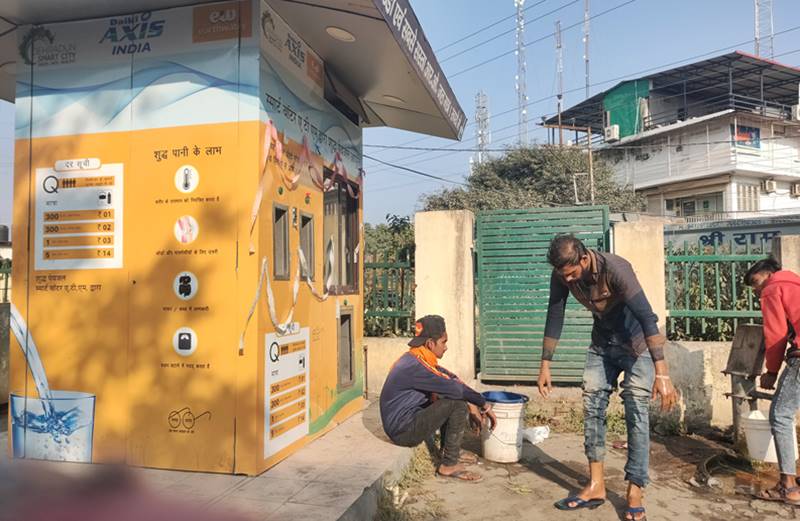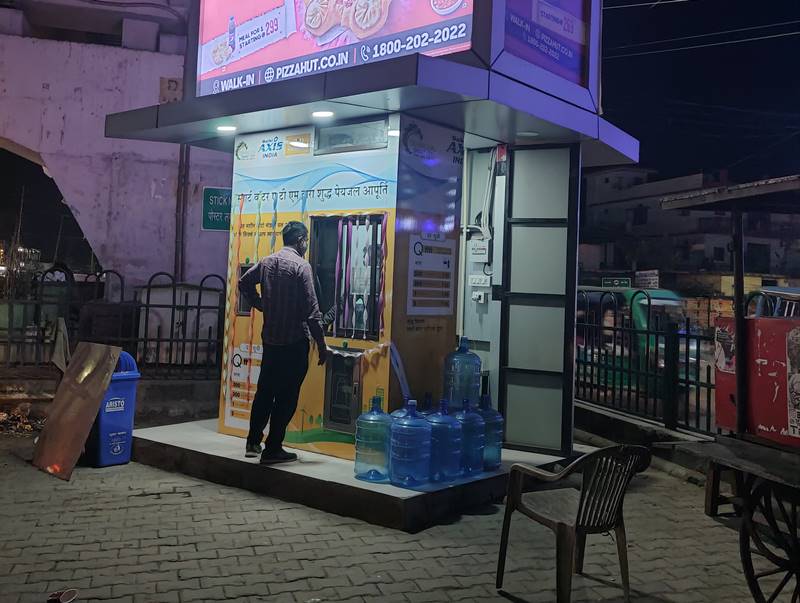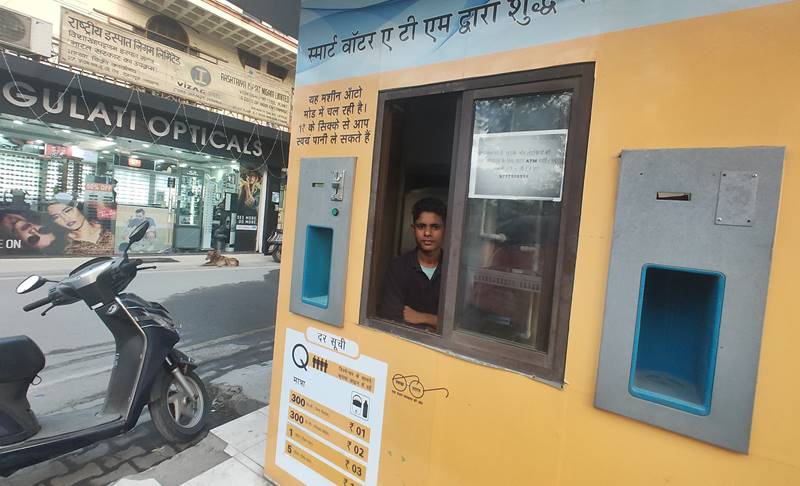Dehradun’s smart water ATMs provide clean drinking water at an affordable price
As part of the Smart City Dehradun project, 24 water ATMs have been installed at various locations in the capital of Uttarakhand. Shopkeepers, slum dwellers, migrant workers and travellers find these ATMs convenient. Fifty per cent of the ATM operators are women.


Most of these ATMs are installed in busy market places, or areas widely used by the public.
Dehradun, Uttarakhand
Sartaj is happy. The 45-year-old peanut seller, who earns a livelihood at Dehradun’s busy bus terminus, does not have to carry water all the way from home like he used to before. Right opposite his stall is a water ATM.
“For a rupee, the ATM pumps a glass of cold filtered water (300 ml), and I get an entire litre for three rupees,” he told Gaon Connection. “For street vendors like me, this ATM is ideal to get safe drinking water,” he added.
Shadab Sheikh finds the water ATM useful too. “The ATM saves me from buying a litre of bottled water for twenty rupees. I often travel to Dehradun from Chhutmalpur, my village, for work and such a facility helps passengers like me afford clean drinking water,” the 58-year-old rice trader from the neighbouring Uttar Pradesh told Gaon Connection. He said he always carried a water bottle with him, which he could refill as many times as he wanted at a nominal cost from the water ATM without having to buy expensive bottled water.
Also Read: ‘90% diarrhoea deaths in India due to lack of safe drinking water and basic sanitation facilities’

As part of the Smart City Dehradun project, under a public-private partnership, 24 water ATMs have been installed at various locations in Dehradun, the capital of Uttarakhand. During the COVID-19 lockdown last year, 15 water ATMs were already functional, and now all the 24 are dispensing safe drinking water.
After a successful trial, on November 9, earlier this month, these ATMs were officially dedicated to the public by Uttarakhand’s Chief Minister Pushkar Singh Dhami, during the 21st Foundation Day celebration of the state. Uttarakhand came into being on November 9, 2000.
Meeting the water demand
Most of these ATMs are installed in busy market places, or areas widely used by the public. For example, there is a water ATM at the railway station exit; one is stationed near Dehradun’s landmark clocktower; and sometimes in residential areas too such as MDDA colony in Dalanwala.
“In Dalanwala, people rely on tankers, borewells, and piped water supply. In summers, the ATM that was installed last year during the lockdown came to the rescue of the slum dwellers of MDDA colony,” Arun Kumar, a 26-year old resident of the colony, told Gaon Connection. People queued to take water at the ATM when water supply in this area dwindled, he added.
At three locations where water ATMs have been installed, shopkeepers can also avail of a door-to-door service.
For example, there are many shops near the ATM installed under the Ballupur Chowk flyover. If the shopkeepers desire, a 20-litre camper of cold water costing Rs 56, can be delivered to them. For this, the shopkeepers have to pay a security deposit of Rs 200.
“This works out to be about fifty to seventy five per cent cheaper than the market rate,” one of the shopkeepers who has opted for this service, told Gaon Connection.

Smart, user friendly technology
The ATM design is easy to use and a display board shows the level of total dissolved solids (TDS), water level, pH, and temperature. The design is compact.
The water to these ATMs is supplied through a piped line by the Uttarakhand Peyjal Nigam, which is responsible for planning, survey, design and execution of urban as well as rural water supply and sewerage schemes in the hill state. The piped water is stored beneath the ATM which is then pumped to the overhead purifying tanks using a motor. These tanks are of three capacities – 200 litres, 500 litres and 1,000 litres.
Also Read: Study finds high presence of microplastics in water samples collected from across Goa
The reverse osmosis (RO) system purifies the water before it is dispensed to the buyers. The temperature of the water can be regulated to provide room temperature or chilled water. The RO used in the ATM uses a new technology called Capacitive Deionization (CDI). This emerging water purifying technology has improved RO systems and reduced the wastage of water.
According to Daiki Axis Environment Pvt Ltd, a private company that is running these water ATMs in Dehradun, the percentage of wasted water is 80-95 per cent less compared to conventional RO. Only 20 per cent water is wasted (in RO process) in these new water ATMs, it said.
“This is a high recovery technology that wastes less water during treatment compared to conventional RO systems. Nearly 60 per cent water gets wasted in the conventional RO system. But the system used in the water ATM recovers upto 95 per cent of the water,” Kamal Tiwari, director, Daiki Axis Environment Pvt Ltd, told Gaon Connection. Also, the technology is energy efficient, and the operating cost per litre is low. Using this technology we can adjust the water chemistry, the director added.
Reducing disease burden
Water pollution is a growing concern in Dehradun, as revealed by a 2016 study titled International Journal of Environmental Rehabilitation and Conservation, by Anil Kumar Pal, lead author and professor at Dehradun’s DBS College.
“We found a steady rise in incidences of water-borne diseases. For example, the total annual incidence rate of diarrhoea, malaria, cholera, typhoid, and gastroenteritis (patient per 1,000 persons) were found more in Patel Nagar and Majra, followed by Dalanwala, Deepnagar, Vasant Vihar, Nehru Colony, and Rajpur,” Pal told Gaon Connection.
“In such a scenario, these water ATMs may reduce the burden of water-borne diseases in Dehradun. Since water ATMs are installed in localities like Dalanwala, Patel Nagar, and Nehru Colony, in the future, it will be worthwhile to reassess the situation,” the professor observed.
Women ATM operators
An operator has been deployed at each ATM unit to assist customers.
“Fifty per cent of the operators of the ATM are women,” PN Rai, city coordinator of water ATM for Daiki Axis Environment Pvt. Ltd told Gaon Connection.
These water ATMs function 24*7. An operator, who gets a salary of Rs 5,000 a month, assists the customers during the day from 9 am to 7 pm. After the operator leaves in the evening, the ATM is put on an auto coin mode. This means that any customer can then put a coin to automatically get drinking water.
“The timings are comfortable and safe for young women who want to support their families or themselves in the city,” Shobha, a 23-year-old who assists the vegetable vendors, wholesalers and buyers at the nearby Niranjanpur subzi mandi, told Gaon Connection.
Surya Prakash, another ATM operator at Parade ground, swiped his identity card (RFID or Radio Frequency Identification card) before drawing the water for a customer. “Everything is automated and is directly fed into the system. At the end of the day, a report is generated on water sales. By the end of the month, we get paid a basic salary and a top-up incentive if the sale is satisfactory,” he explained.
Teething troubles
However, there are a few wrinkles in the system that need ironing out. After the operators leave for the day, the water ATMs are put on auto mode. “But at times when purified water gets exhausted, which is common during the night or early morning hours, the vending machine does not return the money,” a street-food cart owner outside Gandhi Park, cautioned.
Rinku, who works at a small eatery in Transport Nagar, said he is forced to fill water from the handpump next to the water ATM. “The ATM dispenses clean drinking water but it has not been functioning for a few days,” he said. “Drawing more than five litres of water needs the help of an operator. Also, the ATM takes only coins,” he pointed out.
According to Tiwari, water dispensing from ATMs is not a new concept. But, it is still nascent in the country. Most of these ATMs operate in public-private mode, and the challenge is to see how to make it self-sustainable.
Also Read: ‘It is poison, not water, that comes out of the handpumps’
For example, the Dehradun model follows public-private partnership and is completely funded by Daiki Axis. Under this arrangement, the company helps the state government provide clean drinking water to people. To make it self-sustainable, the space above the ATM is open for advertisers. “The revenue generated through ad placement is one way of managing the operational costs,” pointed out Tiwari.
The water ATMs can also help reduce plastic waste, as Shweta Nakra Kandwal, a banking professional who recently discovered the ATM, told Gaon Connection. “I think this is a wonderful concept. This way it will encourage people to carry their own water bottles,” Kandwal said. “But not many people know about them. Perhaps, there is apprehension among the city dwellers on the water quality or utility of these water banks. These challenges need to be addressed,” she suggested.
“These ATMs have the potential to provide safe (quality) drinking water to many poor migrant workers in Dehradun. However, the overall demand and supply gap is only going to increase due to rapid urbanization and unsustainable water use practices,” Vishal Singh, research lead on Urbanization and Water Security at Centre for Ecology Development and Research (CEDAR), a Dehradun-based non-profit, told Gaon Connection.

